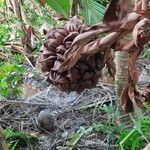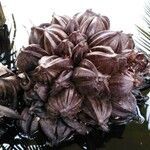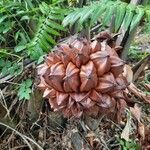A palm with stout creeping underground stems. It forms clumps. The stems lie along the ground and are underground in soft mud. The leaves have leaflets along a 7 m long axis. The leaves occur in erect clusters. The leaflets are 0.-1.3 m long by 5-8 cm wide. The fruit are flat and 12 cm long by 10 cm across. They are crowded into a very characteristic large round fruiting head which is borne on a special erect stalk. The female flower is a round head on the end of the stalk and below it long male flowers are produced. The centre of the fruit is edible.
Stems creeping, not visible, dividing equally, to 60 cm in diam., forming large colonies. Leaves stiffly erect; blades to 9 m with 57-100 pinnae per side, these regularly arranged and spreading in same plane. Inflorescences erect, to 2 m. Fruits brown, densely packed in a head-shaped infructescence, each obovoid, angled, to 15 × 10 cm.
A prostrate-stemmed, gregarious palm




